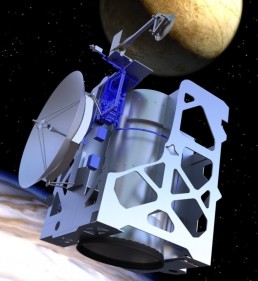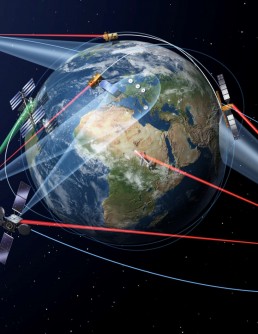Communication Subsystems
Antwerp Space, a leader in the design and development of RF equipment for deep space, GEO, MEO, LEO and inter-satellite communications, is recognized for its outstanding capability to integrate and deliver critical Communication Subsystems.
Our dedicated team of RF specialists, based on its expertise and research actions, continuously creates innovative, efficient and cost effective solutions that will guarantee the success of the most ambitious satellite missions.
Antwerp Space has been awarded multiple contracts for Communication Subsystems, which are integrated ensembles of radio-communications equipment. Current projects are ExoMars 2022 and JUICE, both deep space missions that will respectively target Mars and Jupiter.

ExoMars (Exobiology on Mars)
ExoMars is a space program consisting of two missions, to orbit around Mars, and to land on the planet, executed in cooperation by ESA and Roscosmos, the Russian space agency. The first mission called ExoMars 2016, consisting of an orbiter and an experimental lander, was launched on 14 March 2016 and arrived at Mars in October 2016. The second mission is scheduled for a launch in 2022. It includes a Surface Platform that will land on the planet, bearing instruments and a rover that will explore the Martian surface.
Antwerp Space is the subcontractor for the Carrier Module Communication Subsystem. This enables the teams on Earth to send commands to the spacecraft during the whole duration of the flight of ExoMars 2022 to Mars.

JUICE (JUpiter ICy moons Explorer)
The JUICE spacecraft will provide a thorough investigation of the Jupiter system in all its complexity with emphasis on the three potentially ocean-bearing ‘Galilean’ moons: Ganymede, Europa and Callisto, and their potential habitability. It will be the first spacecraft ever to orbit a moon (Ganymede) of a giant planet.
The Communication Subsystem will allow telemetry, tracking and command of the spacecraft as well as high-rate transmission to Earth of science instrument data.
Antwerp Space is responsible for designing, integrating and testing the Communication Subsystem, before it is installed onto the spacecraft. The detailed design and manufacturing of its different units is subcontracted to different companies in Europe, under the capable supervision of Antwerp Space.
Telemetry, Tracking & Control (TT&C) Transponder
Based on market requirements and in close collaboration with the European Space Agency, Antwerp Space designed and developed a new family of state-of-the-art TT&C transponders.
To answer the increasing demand for SWaP (Size Weight and Power) reduction, the new TT&C is built on a modular platform suitable for deep space, LEO and MEO usage. It will serve science, Earth observation as well as navigation missions.
To complete the family, a slightly different version adapted to Telemetry & Tracking of launchers and space transportation vehicles will be added. This will also allow communication with the operations center through a data-relay satellite, obviating the need for multiple ground stations.

Besides its extreme compactness, the new TT&C family offers the option to significantly improve the return of Earth observation- and scientific missions by strongly increasing the amount of data transmitted to the Earth station. This is performed by adding an X or Ka-band Payload Data Transmission (PDT) module dedicated to the purpose. Furthermore, to optimize the performance of satellites, a ‘deep sleep’ mode has been introduced, in which the power consumption is drastically reduced.
Antwerp Space’s strong heritage in innovative SDR (Software Defined Radio) design, has also been incorporated into this new family of products and allows to easily reconfigure the TT&C unit based on specific customer- or mission needs. This reconfiguration can take place just before launch, but may also be safely performed in flight. The new equipment offers the alternative of switching between several pre-defined configurations. To enable an accurate tracking of the satellite, advanced Pseudo-Noise (PN) and Differential One-way Ranging (DOR) tone ranging solutions can be selected.
Credits:
This development was made possible with support of the Belgian Science Policy Office
Intersatellite Communications
Reconfigurable Data Relay Satellite Modem
ARGO is an advanced reconfigurable high speed Modem developed by Antwerp Space. The modem delivers a fast rate of data transmission (up to 300 Mbit/s) suitable for existing and future satellite missions. The state-of-the-art design of this modem also yields a higher level of flexibility for different communication demands. It uses a high-performance encoding technology for the very first time in Europe and its architecture allows in-flight reconfiguration, by making use of the Antwerp Space qualified Software Defined Radio platform. This has a very innovative architecture and an exceptionally high on-board computational power. The ARGO modem has been selected by MDA Corporation. The first flight model has been launched into orbit for faster communication from the International Space Station (ISS) to Earth via the European Data Relay Satellite System (EDRS).

Cubesats: Communications
Intersatellite Link
Antwerp Space is working alongside Micro- and Nanosatellite manufacturers in order to offer them the most appropriate inter-satellite communication systems for LEO (New Space) constellations. Every constellation of smallsats has its own requirements in relation to its targeted application in terms of bandwidth, frequencies, throughput, size, weight, security and quality. Antwerp Space has developed a unique inter-satellite communication transceiver platform that can be rapidly tailored to our customer’s application needs and budget.
